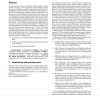Free Online Productivity Tools
i2Speak
i2Symbol
i2OCR
iTex2Img
iWeb2Print
iWeb2Shot
i2Type
iPdf2Split
iPdf2Merge
i2Bopomofo
i2Arabic
i2Style
i2Image
i2PDF
iLatex2Rtf
Sci2ools
VISUALIZATION
1996
IEEE
1996
IEEE
Mesh Reduction with Error Control
In many cases the surfaces of geometric models consist of a large number of triangles. Several algorithms were developed to reduce the number of triangles required to approximate such objects. Algorithms that measure the deviation between the approximated object and the original object are only available for special cases. In this paper we use the Hausdorff distance between the original and the simplified meshas a geometrically meaningfulerror valuewhich can be applied to arbitrary triangle meshes. We present a new algorithm to reduce the number of triangles of a mesh without exceeding a user-defined Hausdorff distance between the original and simplified mesh. As this distance is parameterization-independent, its use as error measure is superior to the use of the
| Added | 07 Aug 2010 |
| Updated | 07 Aug 2010 |
| Type | Conference |
| Year | 1996 |
| Where | VISUALIZATION |
| Authors | Reinhard Klein, Gunther Liebich, Wolfgang Straßer |
Comments (0)

